BUS501: Data Analysis and Strategic Recommendations for Retail Surge
VerifiedAdded on 2023/06/04
|26
|4747
|387
Report
AI Summary
This report presents a comprehensive analysis of Retail Surge, an online retail company, focusing on key business aspects derived from customer data. The analysis identifies the most profitable product categories, with customized products leading in profit and cost. It examines payment method preferences, revealing differences in purchase amounts between PayPal and credit card users. Furthermore, the report investigates customer attitudes across different user groups (light, medium, heavy) and genders, assessing knowledge, satisfaction, preference, purchase intention, likelihood to recommend, and loyalty. Statistical tests, including ANOVA and independent t-tests, are employed to determine significant differences in means across these groups. The findings provide actionable insights for Retail Surge to optimize its product offerings, marketing strategies, and customer engagement efforts, ultimately aiming to improve sales and profitability. Desklib provides access to similar reports and solved assignments for students.
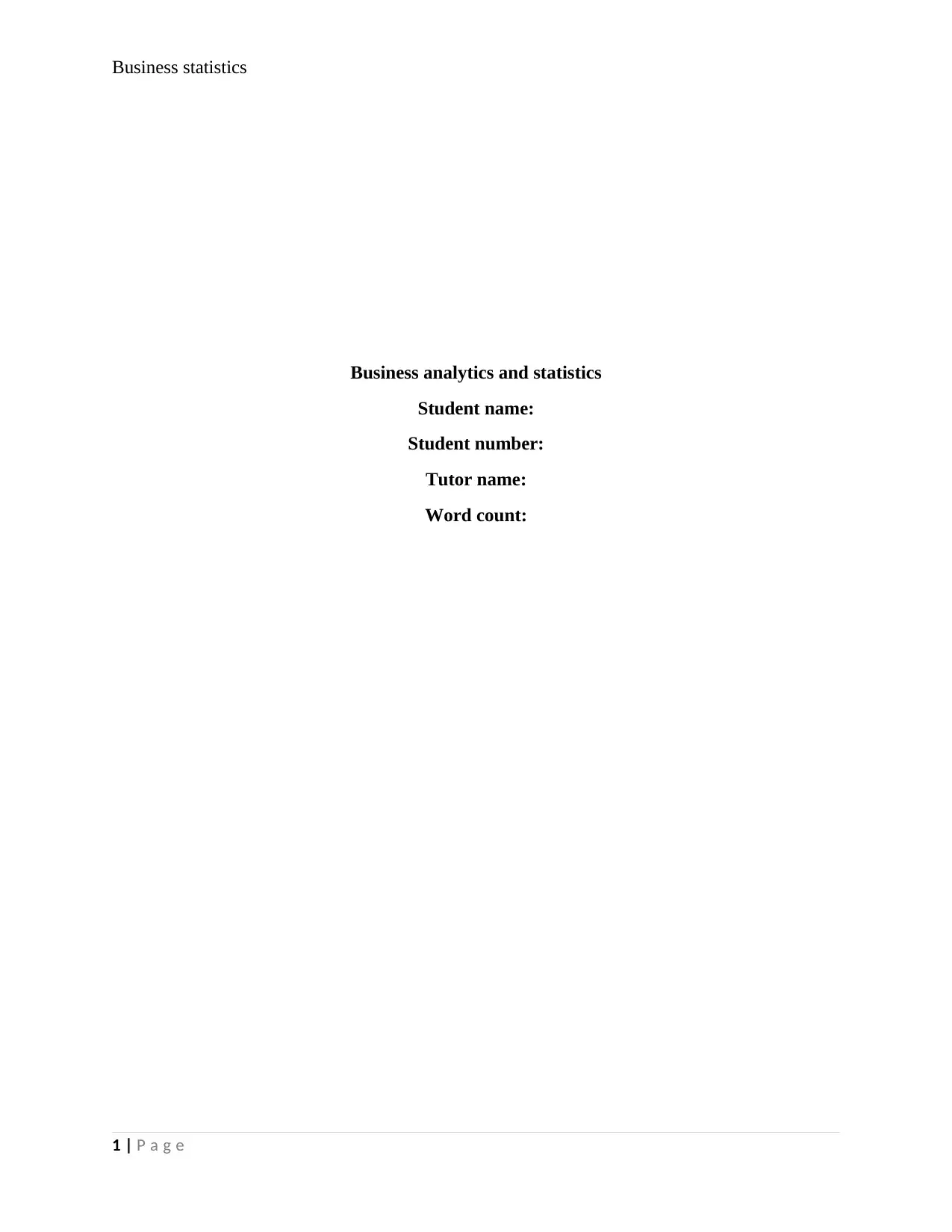
Business statistics
Business analytics and statistics
Student name:
Student number:
Tutor name:
Word count:
1 | P a g e
Business analytics and statistics
Student name:
Student number:
Tutor name:
Word count:
1 | P a g e
Paraphrase This Document
Need a fresh take? Get an instant paraphrase of this document with our AI Paraphraser

Business statistics
Table of Contents
1.0 Introduction...........................................................................................................................................3
2.0 Problem definition.................................................................................................................................3
3.0 Analysis and results...............................................................................................................................5
3.1 Which product categories are making the most profit?....................................................................5
3.2 Which product category costs the most (COGS)?..............................................................................6
3.3 Is there a difference in payments methods?.....................................................................................7
3.4 Are there any differences in the user groups on all of the customer attitudes? (6 outcomes)..........7
3.5 Test for the difference in means of user groups between different customer attitudes.................11
3.6 Are there any differences in gender on all of the customer attitudes? (6 outcomes).....................15
4.0 Discussion and recommendation.........................................................................................................20
Reference...................................................................................................................................................21
Appendix...................................................................................................................................................22
2 | P a g e
Table of Contents
1.0 Introduction...........................................................................................................................................3
2.0 Problem definition.................................................................................................................................3
3.0 Analysis and results...............................................................................................................................5
3.1 Which product categories are making the most profit?....................................................................5
3.2 Which product category costs the most (COGS)?..............................................................................6
3.3 Is there a difference in payments methods?.....................................................................................7
3.4 Are there any differences in the user groups on all of the customer attitudes? (6 outcomes)..........7
3.5 Test for the difference in means of user groups between different customer attitudes.................11
3.6 Are there any differences in gender on all of the customer attitudes? (6 outcomes).....................15
4.0 Discussion and recommendation.........................................................................................................20
Reference...................................................................................................................................................21
Appendix...................................................................................................................................................22
2 | P a g e
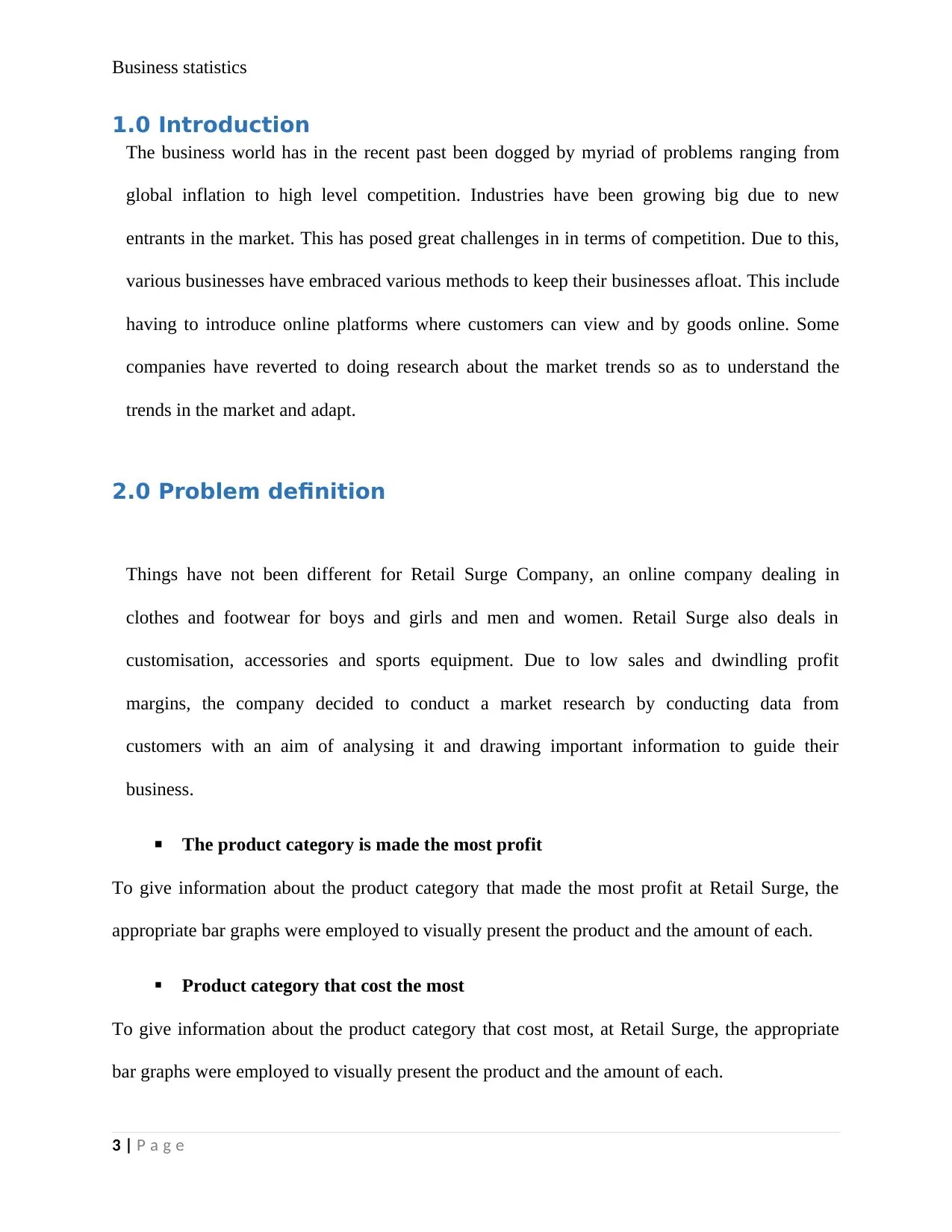
Business statistics
1.0 Introduction
The business world has in the recent past been dogged by myriad of problems ranging from
global inflation to high level competition. Industries have been growing big due to new
entrants in the market. This has posed great challenges in in terms of competition. Due to this,
various businesses have embraced various methods to keep their businesses afloat. This include
having to introduce online platforms where customers can view and by goods online. Some
companies have reverted to doing research about the market trends so as to understand the
trends in the market and adapt.
2.0 Problem definition
Things have not been different for Retail Surge Company, an online company dealing in
clothes and footwear for boys and girls and men and women. Retail Surge also deals in
customisation, accessories and sports equipment. Due to low sales and dwindling profit
margins, the company decided to conduct a market research by conducting data from
customers with an aim of analysing it and drawing important information to guide their
business.
The product category is made the most profit
To give information about the product category that made the most profit at Retail Surge, the
appropriate bar graphs were employed to visually present the product and the amount of each.
Product category that cost the most
To give information about the product category that cost most, at Retail Surge, the appropriate
bar graphs were employed to visually present the product and the amount of each.
3 | P a g e
1.0 Introduction
The business world has in the recent past been dogged by myriad of problems ranging from
global inflation to high level competition. Industries have been growing big due to new
entrants in the market. This has posed great challenges in in terms of competition. Due to this,
various businesses have embraced various methods to keep their businesses afloat. This include
having to introduce online platforms where customers can view and by goods online. Some
companies have reverted to doing research about the market trends so as to understand the
trends in the market and adapt.
2.0 Problem definition
Things have not been different for Retail Surge Company, an online company dealing in
clothes and footwear for boys and girls and men and women. Retail Surge also deals in
customisation, accessories and sports equipment. Due to low sales and dwindling profit
margins, the company decided to conduct a market research by conducting data from
customers with an aim of analysing it and drawing important information to guide their
business.
The product category is made the most profit
To give information about the product category that made the most profit at Retail Surge, the
appropriate bar graphs were employed to visually present the product and the amount of each.
Product category that cost the most
To give information about the product category that cost most, at Retail Surge, the appropriate
bar graphs were employed to visually present the product and the amount of each.
3 | P a g e
⊘ This is a preview!⊘
Do you want full access?
Subscribe today to unlock all pages.

Trusted by 1+ million students worldwide
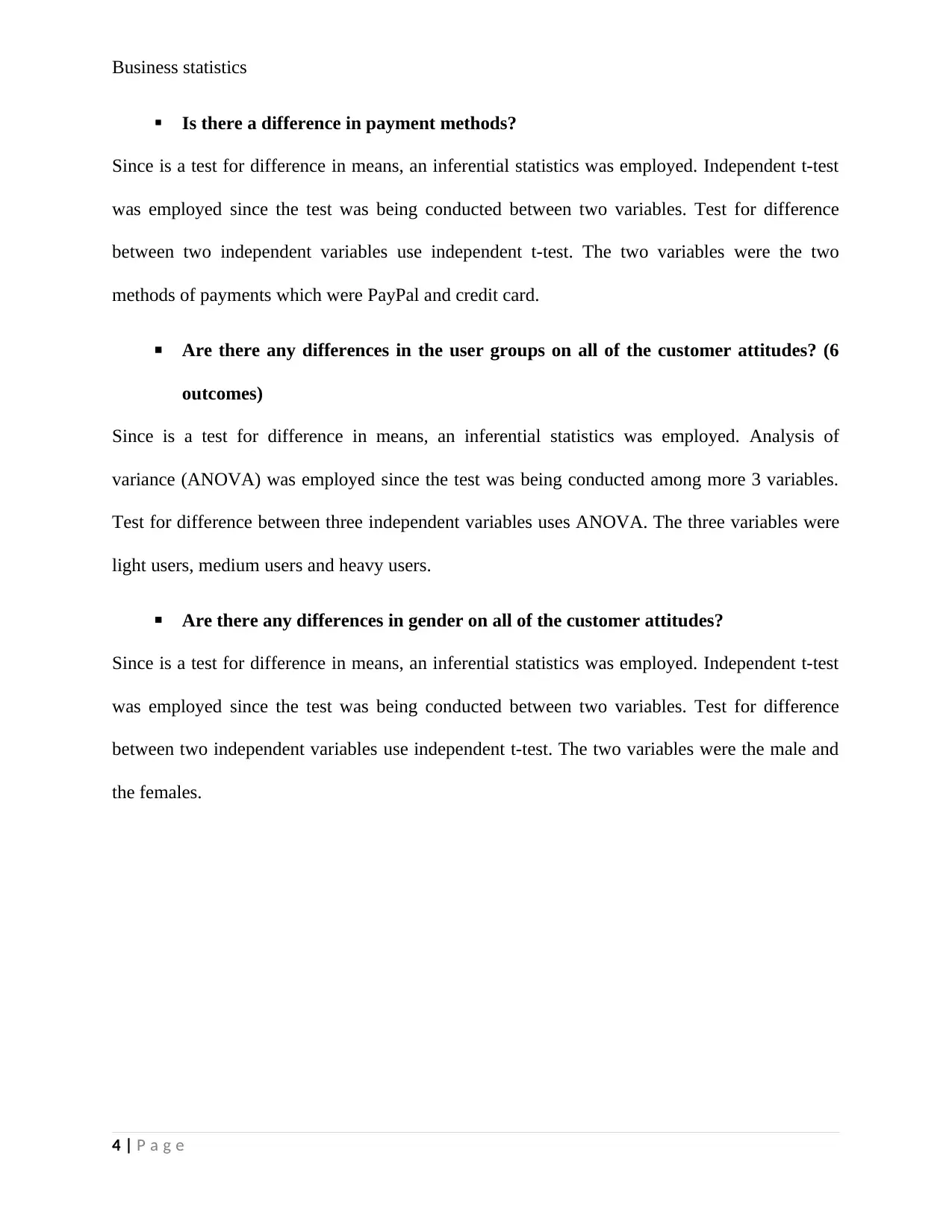
Business statistics
Is there a difference in payment methods?
Since is a test for difference in means, an inferential statistics was employed. Independent t-test
was employed since the test was being conducted between two variables. Test for difference
between two independent variables use independent t-test. The two variables were the two
methods of payments which were PayPal and credit card.
Are there any differences in the user groups on all of the customer attitudes? (6
outcomes)
Since is a test for difference in means, an inferential statistics was employed. Analysis of
variance (ANOVA) was employed since the test was being conducted among more 3 variables.
Test for difference between three independent variables uses ANOVA. The three variables were
light users, medium users and heavy users.
Are there any differences in gender on all of the customer attitudes?
Since is a test for difference in means, an inferential statistics was employed. Independent t-test
was employed since the test was being conducted between two variables. Test for difference
between two independent variables use independent t-test. The two variables were the male and
the females.
4 | P a g e
Is there a difference in payment methods?
Since is a test for difference in means, an inferential statistics was employed. Independent t-test
was employed since the test was being conducted between two variables. Test for difference
between two independent variables use independent t-test. The two variables were the two
methods of payments which were PayPal and credit card.
Are there any differences in the user groups on all of the customer attitudes? (6
outcomes)
Since is a test for difference in means, an inferential statistics was employed. Analysis of
variance (ANOVA) was employed since the test was being conducted among more 3 variables.
Test for difference between three independent variables uses ANOVA. The three variables were
light users, medium users and heavy users.
Are there any differences in gender on all of the customer attitudes?
Since is a test for difference in means, an inferential statistics was employed. Independent t-test
was employed since the test was being conducted between two variables. Test for difference
between two independent variables use independent t-test. The two variables were the male and
the females.
4 | P a g e
Paraphrase This Document
Need a fresh take? Get an instant paraphrase of this document with our AI Paraphraser

Business statistics
3.0 Analysis and results
3.1 Which product categories are making the most profit?
Figure 1
Figure 1 above is a bar chart showing the mean total profit of different products sold by Retail
Surge. The product which fetched the highest profit was the customised products ($ 25). The
second best product in terms of mean profit was men’s shoes ($15.5). The product that fetched
the least profit was boys clothing.
5 | P a g e
3.0 Analysis and results
3.1 Which product categories are making the most profit?
Figure 1
Figure 1 above is a bar chart showing the mean total profit of different products sold by Retail
Surge. The product which fetched the highest profit was the customised products ($ 25). The
second best product in terms of mean profit was men’s shoes ($15.5). The product that fetched
the least profit was boys clothing.
5 | P a g e
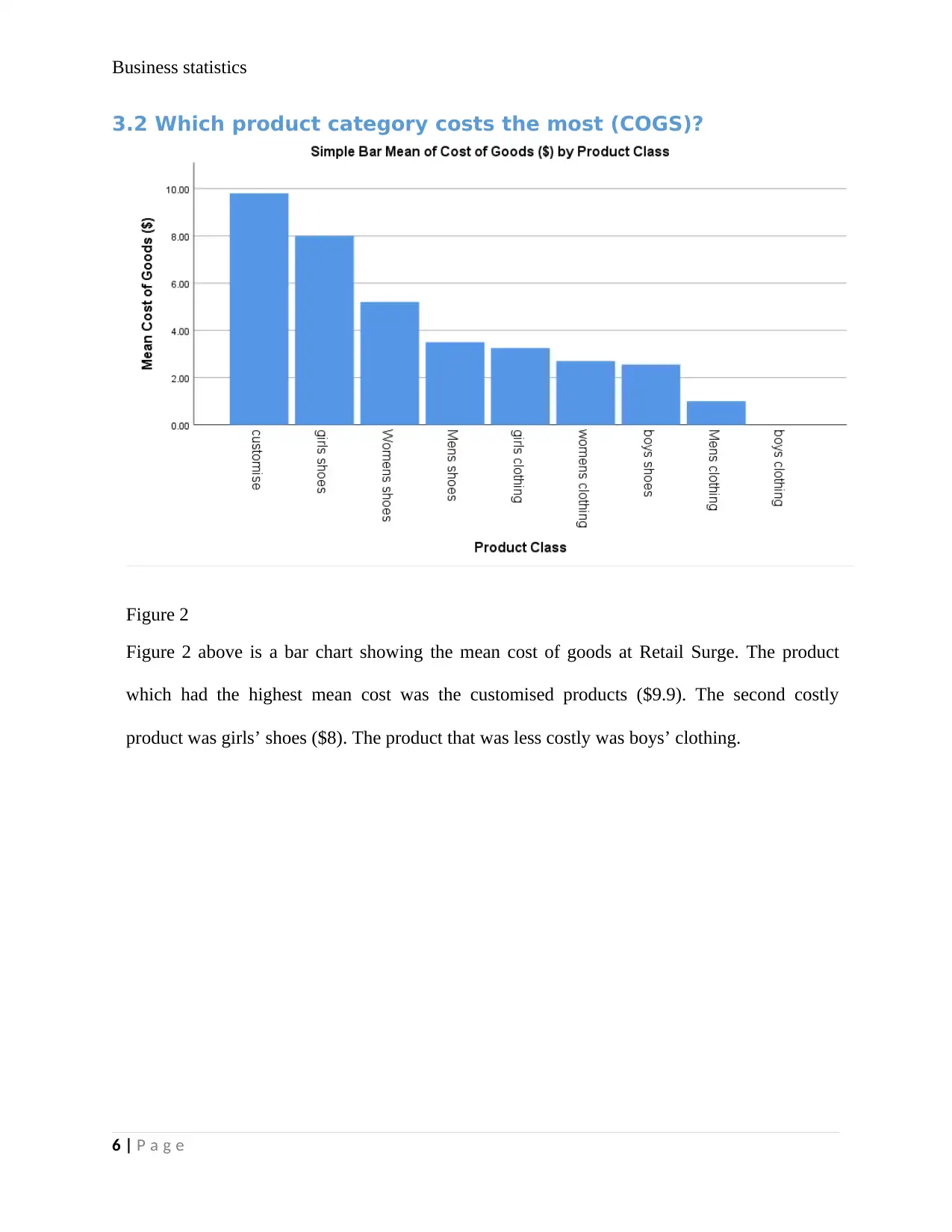
Business statistics
3.2 Which product category costs the most (COGS)?
Figure 2
Figure 2 above is a bar chart showing the mean cost of goods at Retail Surge. The product
which had the highest mean cost was the customised products ($9.9). The second costly
product was girls’ shoes ($8). The product that was less costly was boys’ clothing.
6 | P a g e
3.2 Which product category costs the most (COGS)?
Figure 2
Figure 2 above is a bar chart showing the mean cost of goods at Retail Surge. The product
which had the highest mean cost was the customised products ($9.9). The second costly
product was girls’ shoes ($8). The product that was less costly was boys’ clothing.
6 | P a g e
⊘ This is a preview!⊘
Do you want full access?
Subscribe today to unlock all pages.

Trusted by 1+ million students worldwide
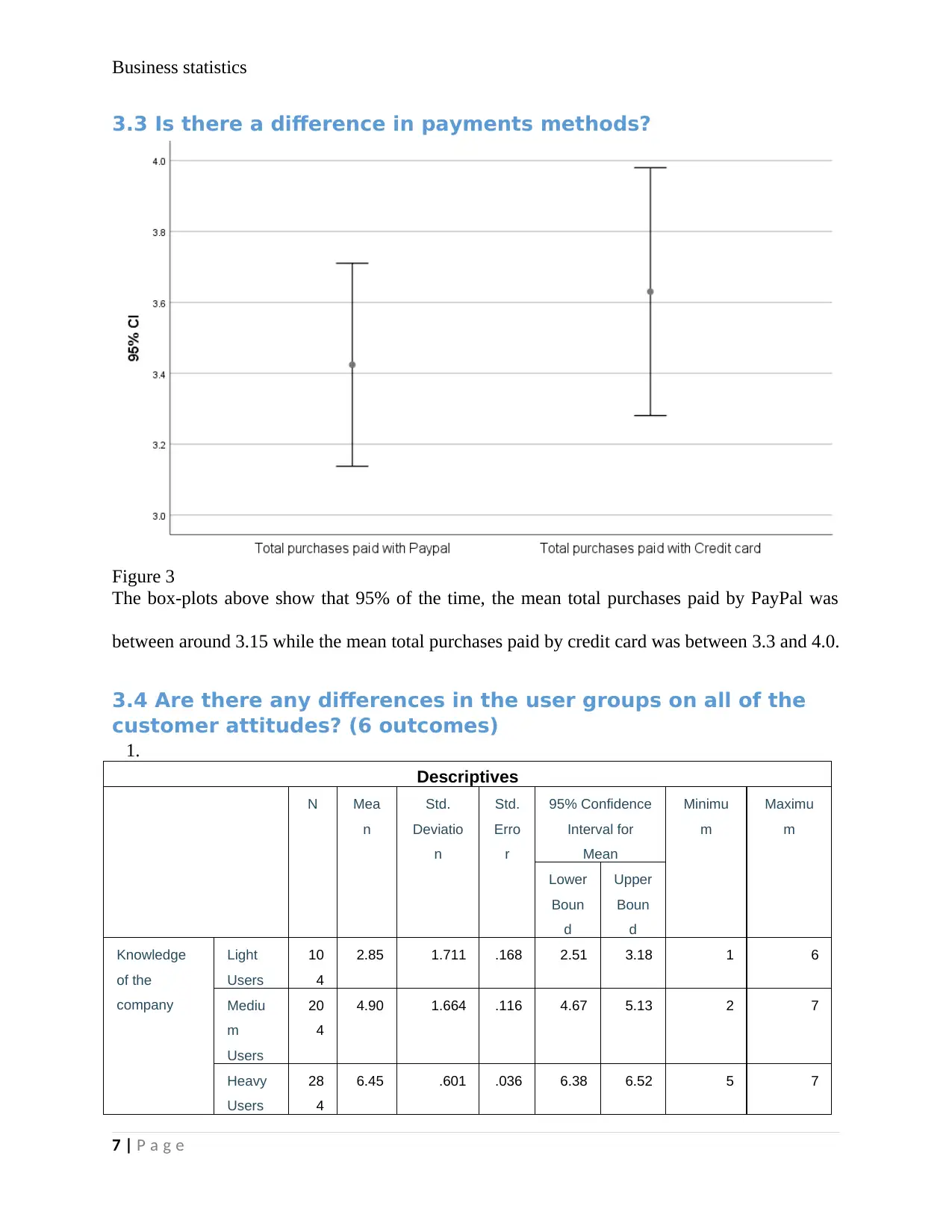
Business statistics
3.3 Is there a difference in payments methods?
Figure 3
The box-plots above show that 95% of the time, the mean total purchases paid by PayPal was
between around 3.15 while the mean total purchases paid by credit card was between 3.3 and 4.0.
3.4 Are there any differences in the user groups on all of the
customer attitudes? (6 outcomes)
1.
Descriptives
N Mea
n
Std.
Deviatio
n
Std.
Erro
r
95% Confidence
Interval for
Mean
Minimu
m
Maximu
m
Lower
Boun
d
Upper
Boun
d
Knowledge
of the
company
Light
Users
10
4
2.85 1.711 .168 2.51 3.18 1 6
Mediu
m
Users
20
4
4.90 1.664 .116 4.67 5.13 2 7
Heavy
Users
28
4
6.45 .601 .036 6.38 6.52 5 7
7 | P a g e
3.3 Is there a difference in payments methods?
Figure 3
The box-plots above show that 95% of the time, the mean total purchases paid by PayPal was
between around 3.15 while the mean total purchases paid by credit card was between 3.3 and 4.0.
3.4 Are there any differences in the user groups on all of the
customer attitudes? (6 outcomes)
1.
Descriptives
N Mea
n
Std.
Deviatio
n
Std.
Erro
r
95% Confidence
Interval for
Mean
Minimu
m
Maximu
m
Lower
Boun
d
Upper
Boun
d
Knowledge
of the
company
Light
Users
10
4
2.85 1.711 .168 2.51 3.18 1 6
Mediu
m
Users
20
4
4.90 1.664 .116 4.67 5.13 2 7
Heavy
Users
28
4
6.45 .601 .036 6.38 6.52 5 7
7 | P a g e
Paraphrase This Document
Need a fresh take? Get an instant paraphrase of this document with our AI Paraphraser
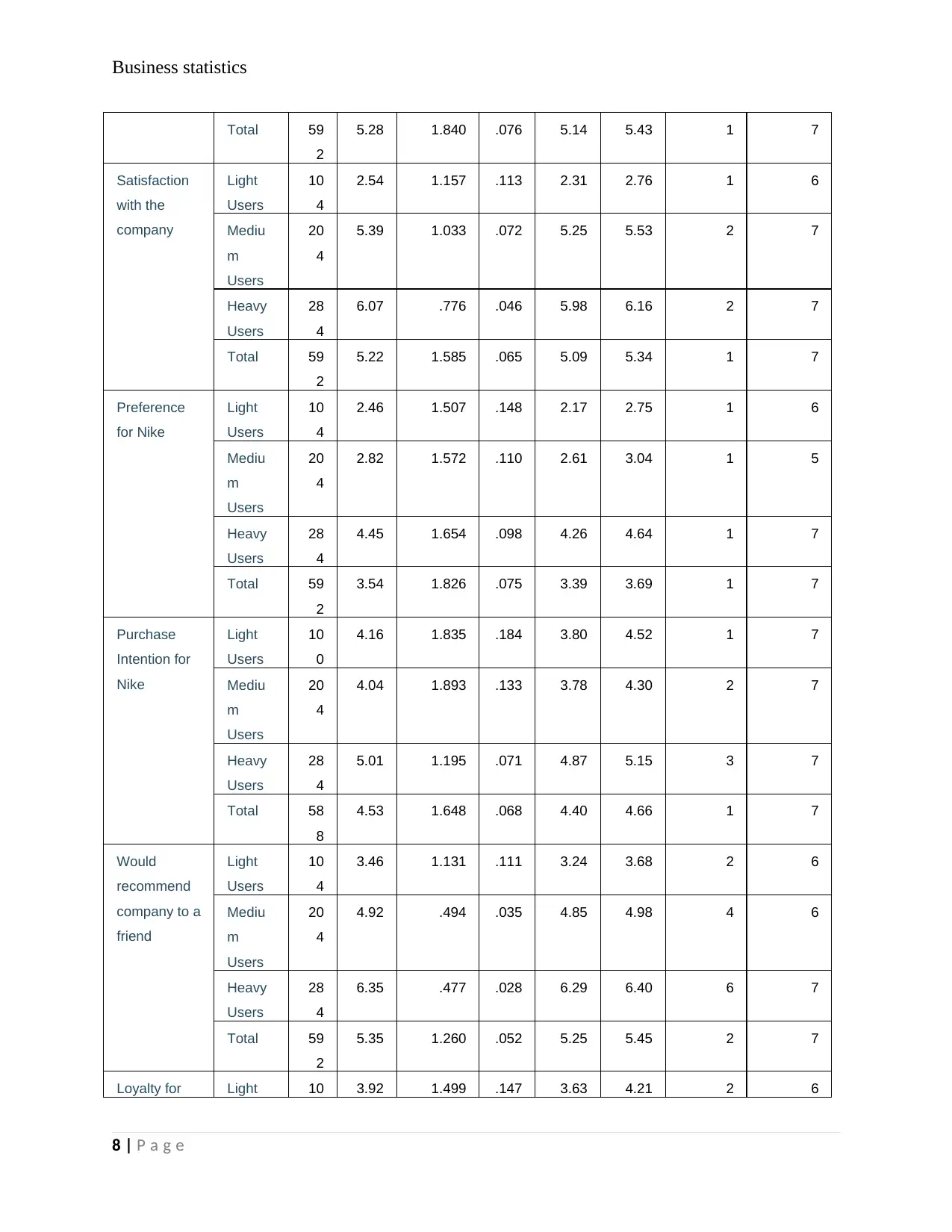
Business statistics
Total 59
2
5.28 1.840 .076 5.14 5.43 1 7
Satisfaction
with the
company
Light
Users
10
4
2.54 1.157 .113 2.31 2.76 1 6
Mediu
m
Users
20
4
5.39 1.033 .072 5.25 5.53 2 7
Heavy
Users
28
4
6.07 .776 .046 5.98 6.16 2 7
Total 59
2
5.22 1.585 .065 5.09 5.34 1 7
Preference
for Nike
Light
Users
10
4
2.46 1.507 .148 2.17 2.75 1 6
Mediu
m
Users
20
4
2.82 1.572 .110 2.61 3.04 1 5
Heavy
Users
28
4
4.45 1.654 .098 4.26 4.64 1 7
Total 59
2
3.54 1.826 .075 3.39 3.69 1 7
Purchase
Intention for
Nike
Light
Users
10
0
4.16 1.835 .184 3.80 4.52 1 7
Mediu
m
Users
20
4
4.04 1.893 .133 3.78 4.30 2 7
Heavy
Users
28
4
5.01 1.195 .071 4.87 5.15 3 7
Total 58
8
4.53 1.648 .068 4.40 4.66 1 7
Would
recommend
company to a
friend
Light
Users
10
4
3.46 1.131 .111 3.24 3.68 2 6
Mediu
m
Users
20
4
4.92 .494 .035 4.85 4.98 4 6
Heavy
Users
28
4
6.35 .477 .028 6.29 6.40 6 7
Total 59
2
5.35 1.260 .052 5.25 5.45 2 7
Loyalty for Light 10 3.92 1.499 .147 3.63 4.21 2 6
8 | P a g e
Total 59
2
5.28 1.840 .076 5.14 5.43 1 7
Satisfaction
with the
company
Light
Users
10
4
2.54 1.157 .113 2.31 2.76 1 6
Mediu
m
Users
20
4
5.39 1.033 .072 5.25 5.53 2 7
Heavy
Users
28
4
6.07 .776 .046 5.98 6.16 2 7
Total 59
2
5.22 1.585 .065 5.09 5.34 1 7
Preference
for Nike
Light
Users
10
4
2.46 1.507 .148 2.17 2.75 1 6
Mediu
m
Users
20
4
2.82 1.572 .110 2.61 3.04 1 5
Heavy
Users
28
4
4.45 1.654 .098 4.26 4.64 1 7
Total 59
2
3.54 1.826 .075 3.39 3.69 1 7
Purchase
Intention for
Nike
Light
Users
10
0
4.16 1.835 .184 3.80 4.52 1 7
Mediu
m
Users
20
4
4.04 1.893 .133 3.78 4.30 2 7
Heavy
Users
28
4
5.01 1.195 .071 4.87 5.15 3 7
Total 58
8
4.53 1.648 .068 4.40 4.66 1 7
Would
recommend
company to a
friend
Light
Users
10
4
3.46 1.131 .111 3.24 3.68 2 6
Mediu
m
Users
20
4
4.92 .494 .035 4.85 4.98 4 6
Heavy
Users
28
4
6.35 .477 .028 6.29 6.40 6 7
Total 59
2
5.35 1.260 .052 5.25 5.45 2 7
Loyalty for Light 10 3.92 1.499 .147 3.63 4.21 2 6
8 | P a g e

Business statistics
Nike Users 4
Mediu
m
Users
20
4
4.14 1.563 .109 3.92 4.35 2 6
Heavy
Users
28
4
3.92 1.575 .093 3.73 4.10 2 7
Total 59
2
3.99 1.559 .064 3.87 4.12 2 7
Test of Homogeneity of Variances
Levene
Statistic
df1 df2 Sig.
Knowledge of the
company
Based on Mean 137.679 2 589 .000
Based on Median 43.167 2 589 .000
Based on Median and
with adjusted df
43.167 2 366.541 .000
Based on trimmed mean 130.226 2 589 .000
Satisfacition with the
company
Based on Mean 34.012 2 589 .000
Based on Median 19.318 2 589 .000
Based on Median and
with adjusted df
19.318 2 543.743 .000
Based on trimmed mean 28.470 2 589 .000
Preference for Nike Based on Mean 3.007 2 589 .050
Based on Median 2.032 2 589 .132
Based on Median and
with adjusted df
2.032 2 534.316 .132
Based on trimmed mean 3.259 2 589 .039
Purchase Intention for
Nike
Based on Mean 51.499 2 585 .000
Based on Median 48.655 2 585 .000
Based on Median and
with adjusted df
48.655 2 555.807 .000
Based on trimmed mean 49.574 2 585 .000
Would recommend
company to a friend
Based on Mean 155.697 2 589 .000
Based on Median 75.229 2 589 .000
Based on Median and
with adjusted df
75.229 2 489.408 .000
Based on trimmed mean 152.051 2 589 .000
Loyalty for Nike Based on Mean .438 2 589 .645
Based on Median 1.134 2 589 .322
9 | P a g e
Nike Users 4
Mediu
m
Users
20
4
4.14 1.563 .109 3.92 4.35 2 6
Heavy
Users
28
4
3.92 1.575 .093 3.73 4.10 2 7
Total 59
2
3.99 1.559 .064 3.87 4.12 2 7
Test of Homogeneity of Variances
Levene
Statistic
df1 df2 Sig.
Knowledge of the
company
Based on Mean 137.679 2 589 .000
Based on Median 43.167 2 589 .000
Based on Median and
with adjusted df
43.167 2 366.541 .000
Based on trimmed mean 130.226 2 589 .000
Satisfacition with the
company
Based on Mean 34.012 2 589 .000
Based on Median 19.318 2 589 .000
Based on Median and
with adjusted df
19.318 2 543.743 .000
Based on trimmed mean 28.470 2 589 .000
Preference for Nike Based on Mean 3.007 2 589 .050
Based on Median 2.032 2 589 .132
Based on Median and
with adjusted df
2.032 2 534.316 .132
Based on trimmed mean 3.259 2 589 .039
Purchase Intention for
Nike
Based on Mean 51.499 2 585 .000
Based on Median 48.655 2 585 .000
Based on Median and
with adjusted df
48.655 2 555.807 .000
Based on trimmed mean 49.574 2 585 .000
Would recommend
company to a friend
Based on Mean 155.697 2 589 .000
Based on Median 75.229 2 589 .000
Based on Median and
with adjusted df
75.229 2 489.408 .000
Based on trimmed mean 152.051 2 589 .000
Loyalty for Nike Based on Mean .438 2 589 .645
Based on Median 1.134 2 589 .322
9 | P a g e
⊘ This is a preview!⊘
Do you want full access?
Subscribe today to unlock all pages.

Trusted by 1+ million students worldwide
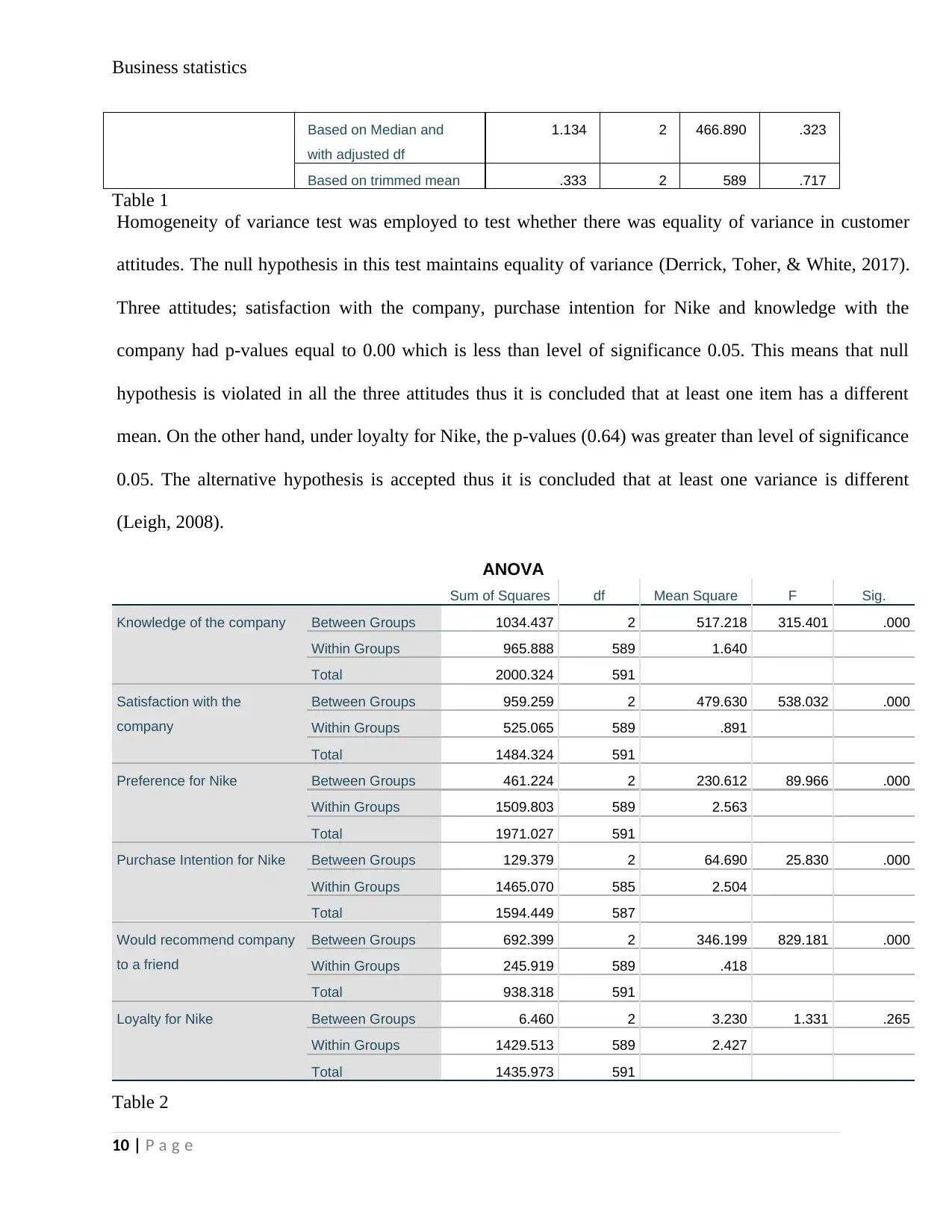
Business statistics
Based on Median and
with adjusted df
1.134 2 466.890 .323
Based on trimmed mean .333 2 589 .717
Table 1
Homogeneity of variance test was employed to test whether there was equality of variance in customer
attitudes. The null hypothesis in this test maintains equality of variance (Derrick, Toher, & White, 2017).
Three attitudes; satisfaction with the company, purchase intention for Nike and knowledge with the
company had p-values equal to 0.00 which is less than level of significance 0.05. This means that null
hypothesis is violated in all the three attitudes thus it is concluded that at least one item has a different
mean. On the other hand, under loyalty for Nike, the p-values (0.64) was greater than level of significance
0.05. The alternative hypothesis is accepted thus it is concluded that at least one variance is different
(Leigh, 2008).
ANOVA
Sum of Squares df Mean Square F Sig.
Knowledge of the company Between Groups 1034.437 2 517.218 315.401 .000
Within Groups 965.888 589 1.640
Total 2000.324 591
Satisfaction with the
company
Between Groups 959.259 2 479.630 538.032 .000
Within Groups 525.065 589 .891
Total 1484.324 591
Preference for Nike Between Groups 461.224 2 230.612 89.966 .000
Within Groups 1509.803 589 2.563
Total 1971.027 591
Purchase Intention for Nike Between Groups 129.379 2 64.690 25.830 .000
Within Groups 1465.070 585 2.504
Total 1594.449 587
Would recommend company
to a friend
Between Groups 692.399 2 346.199 829.181 .000
Within Groups 245.919 589 .418
Total 938.318 591
Loyalty for Nike Between Groups 6.460 2 3.230 1.331 .265
Within Groups 1429.513 589 2.427
Total 1435.973 591
Table 2
10 | P a g e
Based on Median and
with adjusted df
1.134 2 466.890 .323
Based on trimmed mean .333 2 589 .717
Table 1
Homogeneity of variance test was employed to test whether there was equality of variance in customer
attitudes. The null hypothesis in this test maintains equality of variance (Derrick, Toher, & White, 2017).
Three attitudes; satisfaction with the company, purchase intention for Nike and knowledge with the
company had p-values equal to 0.00 which is less than level of significance 0.05. This means that null
hypothesis is violated in all the three attitudes thus it is concluded that at least one item has a different
mean. On the other hand, under loyalty for Nike, the p-values (0.64) was greater than level of significance
0.05. The alternative hypothesis is accepted thus it is concluded that at least one variance is different
(Leigh, 2008).
ANOVA
Sum of Squares df Mean Square F Sig.
Knowledge of the company Between Groups 1034.437 2 517.218 315.401 .000
Within Groups 965.888 589 1.640
Total 2000.324 591
Satisfaction with the
company
Between Groups 959.259 2 479.630 538.032 .000
Within Groups 525.065 589 .891
Total 1484.324 591
Preference for Nike Between Groups 461.224 2 230.612 89.966 .000
Within Groups 1509.803 589 2.563
Total 1971.027 591
Purchase Intention for Nike Between Groups 129.379 2 64.690 25.830 .000
Within Groups 1465.070 585 2.504
Total 1594.449 587
Would recommend company
to a friend
Between Groups 692.399 2 346.199 829.181 .000
Within Groups 245.919 589 .418
Total 938.318 591
Loyalty for Nike Between Groups 6.460 2 3.230 1.331 .265
Within Groups 1429.513 589 2.427
Total 1435.973 591
Table 2
10 | P a g e
Paraphrase This Document
Need a fresh take? Get an instant paraphrase of this document with our AI Paraphraser
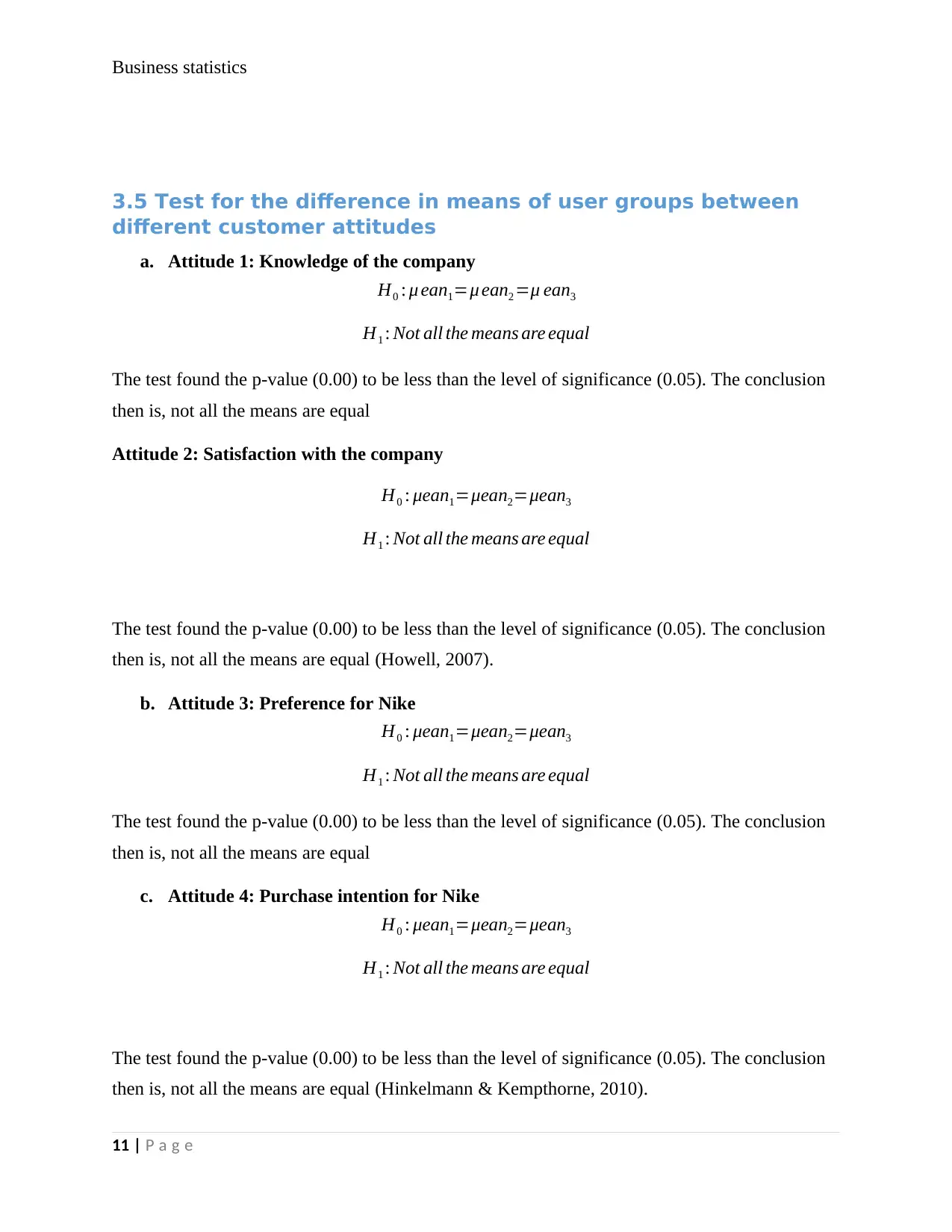
Business statistics
3.5 Test for the difference in means of user groups between
different customer attitudes
a. Attitude 1: Knowledge of the company
H0 : μ ean1=μ ean2 =μ ean3
H1 : Not all the means are equal
The test found the p-value (0.00) to be less than the level of significance (0.05). The conclusion
then is, not all the means are equal
Attitude 2: Satisfaction with the company
H0 : μean1=μean2=μean3
H1 : Not all the means are equal
The test found the p-value (0.00) to be less than the level of significance (0.05). The conclusion
then is, not all the means are equal (Howell, 2007).
b. Attitude 3: Preference for Nike
H0 : μean1=μean2=μean3
H1 : Not all the means are equal
The test found the p-value (0.00) to be less than the level of significance (0.05). The conclusion
then is, not all the means are equal
c. Attitude 4: Purchase intention for Nike
H0 : μean1=μean2=μean3
H1 : Not all the means are equal
The test found the p-value (0.00) to be less than the level of significance (0.05). The conclusion
then is, not all the means are equal (Hinkelmann & Kempthorne, 2010).
11 | P a g e
3.5 Test for the difference in means of user groups between
different customer attitudes
a. Attitude 1: Knowledge of the company
H0 : μ ean1=μ ean2 =μ ean3
H1 : Not all the means are equal
The test found the p-value (0.00) to be less than the level of significance (0.05). The conclusion
then is, not all the means are equal
Attitude 2: Satisfaction with the company
H0 : μean1=μean2=μean3
H1 : Not all the means are equal
The test found the p-value (0.00) to be less than the level of significance (0.05). The conclusion
then is, not all the means are equal (Howell, 2007).
b. Attitude 3: Preference for Nike
H0 : μean1=μean2=μean3
H1 : Not all the means are equal
The test found the p-value (0.00) to be less than the level of significance (0.05). The conclusion
then is, not all the means are equal
c. Attitude 4: Purchase intention for Nike
H0 : μean1=μean2=μean3
H1 : Not all the means are equal
The test found the p-value (0.00) to be less than the level of significance (0.05). The conclusion
then is, not all the means are equal (Hinkelmann & Kempthorne, 2010).
11 | P a g e
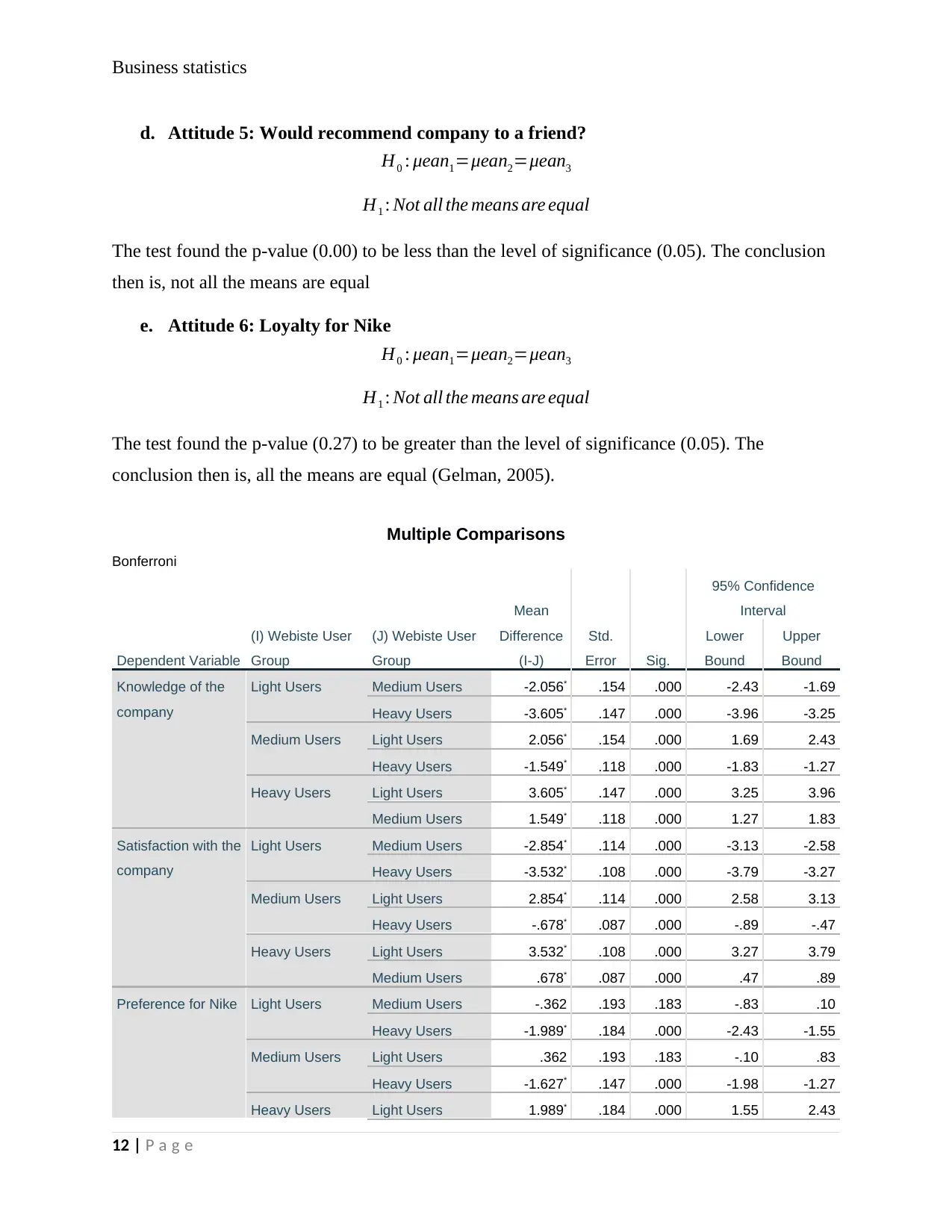
Business statistics
d. Attitude 5: Would recommend company to a friend?
H0 : μean1=μean2=μean3
H1 : Not all the means are equal
The test found the p-value (0.00) to be less than the level of significance (0.05). The conclusion
then is, not all the means are equal
e. Attitude 6: Loyalty for Nike
H0 : μean1=μean2=μean3
H1 : Not all the means are equal
The test found the p-value (0.27) to be greater than the level of significance (0.05). The
conclusion then is, all the means are equal (Gelman, 2005).
Multiple Comparisons
Bonferroni
Dependent Variable
(I) Webiste User
Group
(J) Webiste User
Group
Mean
Difference
(I-J)
Std.
Error Sig.
95% Confidence
Interval
Lower
Bound
Upper
Bound
Knowledge of the
company
Light Users Medium Users -2.056* .154 .000 -2.43 -1.69
Heavy Users -3.605* .147 .000 -3.96 -3.25
Medium Users Light Users 2.056* .154 .000 1.69 2.43
Heavy Users -1.549* .118 .000 -1.83 -1.27
Heavy Users Light Users 3.605* .147 .000 3.25 3.96
Medium Users 1.549* .118 .000 1.27 1.83
Satisfaction with the
company
Light Users Medium Users -2.854* .114 .000 -3.13 -2.58
Heavy Users -3.532* .108 .000 -3.79 -3.27
Medium Users Light Users 2.854* .114 .000 2.58 3.13
Heavy Users -.678* .087 .000 -.89 -.47
Heavy Users Light Users 3.532* .108 .000 3.27 3.79
Medium Users .678* .087 .000 .47 .89
Preference for Nike Light Users Medium Users -.362 .193 .183 -.83 .10
Heavy Users -1.989* .184 .000 -2.43 -1.55
Medium Users Light Users .362 .193 .183 -.10 .83
Heavy Users -1.627* .147 .000 -1.98 -1.27
Heavy Users Light Users 1.989* .184 .000 1.55 2.43
12 | P a g e
d. Attitude 5: Would recommend company to a friend?
H0 : μean1=μean2=μean3
H1 : Not all the means are equal
The test found the p-value (0.00) to be less than the level of significance (0.05). The conclusion
then is, not all the means are equal
e. Attitude 6: Loyalty for Nike
H0 : μean1=μean2=μean3
H1 : Not all the means are equal
The test found the p-value (0.27) to be greater than the level of significance (0.05). The
conclusion then is, all the means are equal (Gelman, 2005).
Multiple Comparisons
Bonferroni
Dependent Variable
(I) Webiste User
Group
(J) Webiste User
Group
Mean
Difference
(I-J)
Std.
Error Sig.
95% Confidence
Interval
Lower
Bound
Upper
Bound
Knowledge of the
company
Light Users Medium Users -2.056* .154 .000 -2.43 -1.69
Heavy Users -3.605* .147 .000 -3.96 -3.25
Medium Users Light Users 2.056* .154 .000 1.69 2.43
Heavy Users -1.549* .118 .000 -1.83 -1.27
Heavy Users Light Users 3.605* .147 .000 3.25 3.96
Medium Users 1.549* .118 .000 1.27 1.83
Satisfaction with the
company
Light Users Medium Users -2.854* .114 .000 -3.13 -2.58
Heavy Users -3.532* .108 .000 -3.79 -3.27
Medium Users Light Users 2.854* .114 .000 2.58 3.13
Heavy Users -.678* .087 .000 -.89 -.47
Heavy Users Light Users 3.532* .108 .000 3.27 3.79
Medium Users .678* .087 .000 .47 .89
Preference for Nike Light Users Medium Users -.362 .193 .183 -.83 .10
Heavy Users -1.989* .184 .000 -2.43 -1.55
Medium Users Light Users .362 .193 .183 -.10 .83
Heavy Users -1.627* .147 .000 -1.98 -1.27
Heavy Users Light Users 1.989* .184 .000 1.55 2.43
12 | P a g e
⊘ This is a preview!⊘
Do you want full access?
Subscribe today to unlock all pages.

Trusted by 1+ million students worldwide
1 out of 26
Related Documents
Your All-in-One AI-Powered Toolkit for Academic Success.
+13062052269
info@desklib.com
Available 24*7 on WhatsApp / Email
![[object Object]](/_next/static/media/star-bottom.7253800d.svg)
Unlock your academic potential
Copyright © 2020–2025 A2Z Services. All Rights Reserved. Developed and managed by ZUCOL.





![Harvest Kitchen: Sales Performance Analysis Report - [Course Name]](/_next/image/?url=https%3A%2F%2Fdesklib.com%2Fmedia%2Fimages%2Fqi%2F14aa28e27baa43b8a0e4a08921cb48ba.jpg&w=256&q=75)